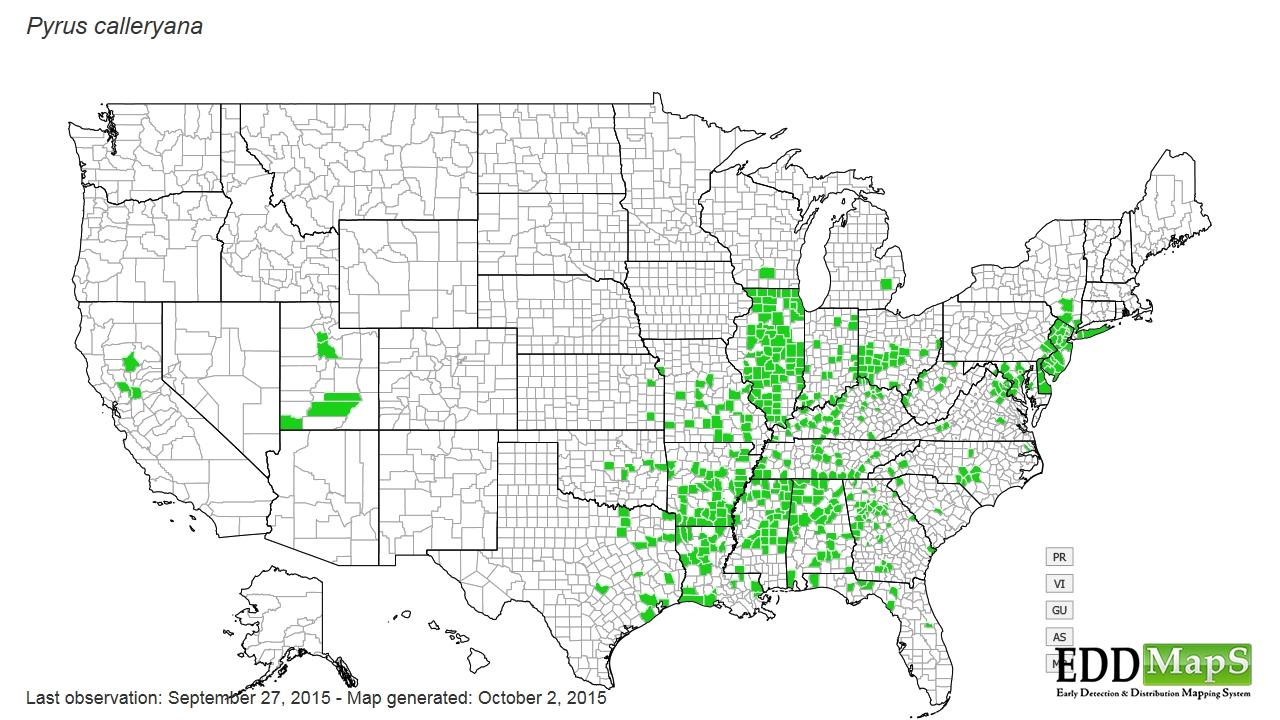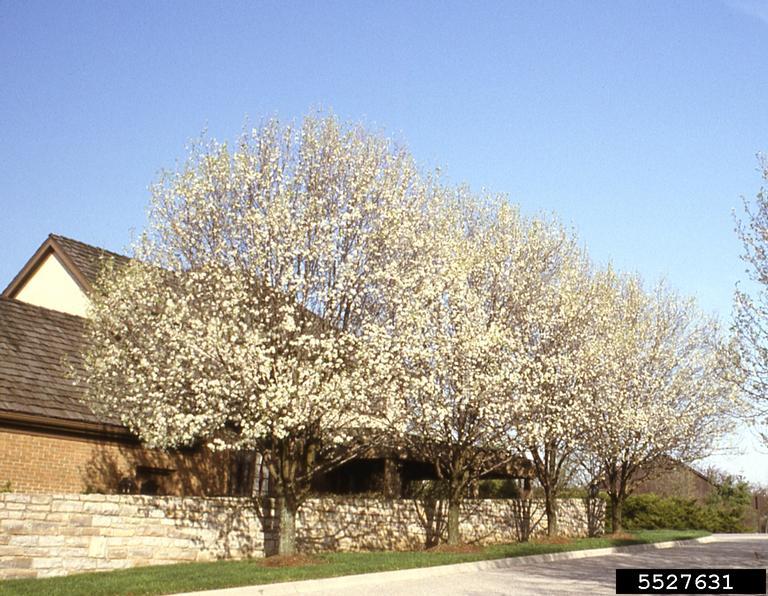Drive along many of Maryland’s major roads in the spring, and you will see what seems like a wall of white, as the Callery pear (and its offshoot, the Bradford pear) are in bloom. While these may be an impressive sight, these trees are an invasive and highly competitive species.
What is it?
The Callery pear was first brought to the United States in 1918 from its native China. At the time, America’s native Bartlett pear trees were threatened by fire blight, and USDA researchers hoped that cross-breeding Callerys with Bartletts would make for a blight-resistant tree.
The resulting trees were studied for thirty years at a USDA facility in Maryland before the project was abandoned without any significant success. However, a few of the trees seemed to have potential as ornamental plantings, and were discovered to be sterile hybrids that would not crossbreed among themselves. These new trees were named for F. W. Bradford, a respected (and retired) scientist who had had nothing to do with the project.
The new hybrids were introduced to the public in the 1960s, but since then, research has discovered that Bradfords are not sterile. They crossbreed indiscriminately with all other pears in the environment. The resulting offspring have reverted to the original Callery pear and have spread across the landscape. Consequently, they are found in great numbers in Maryland, Virginia, and southeastern Pennsylvania, as well as in many other states from New Jersey to Texas. See the distribution map below.

How does it spread?
Callery pears today are most commonly spread by wildlife. Birds and other animals eat and spread the seeds through droppings. These seedlings form dense thickets that push out native plants, growing rapidly in disturbed areas such as fallow fields and roadsides.
How can I identify it?
The Callery pear has a distinctive V-crotch branch structure. See the Image Gallery below.
How can I control it?
If you have Callery pears on your property, take care to note the small fruit it will bear. If possible, remove the fruit before it is eaten by wildlife. Cutting the trees will provide good firewood; however, it is important to ensure that they do not re-sprout. Trunks can be treated with herbicides in several methods, including hack n’ squirt, basal bark and cut stump, with triclopyr or glyphosate.
Seedlings and shallow-rooted plants can be pulled when the soil is moist. Take care to remove the entire root system to prevent re-sprouting.
When the invasives have been removed, replant the area with native species, such as common serviceberry, Allegheny serviceberry, or white fringetree.
For more information:
Learn more about Callery pears:
Callery Pear: Invasive of the Month—Maryland Invasive Species Council
Callery or Bradford Pear— Pennsylvania Dept. of Conservation and Natural Resources
Callery Pear/Bradford Pear—USDA Forest Service
 English
English العربية
العربية Български
Български 简体中文
简体中文 繁體中文
繁體中文 Hrvatski
Hrvatski Čeština
Čeština Dansk
Dansk Nederlands
Nederlands Suomi
Suomi Français
Français Deutsch
Deutsch Ελληνικά
Ελληνικά हिन्दी
हिन्दी Italiano
Italiano 日本語
日本語 한국어
한국어 Norsk bokmål
Norsk bokmål Polski
Polski Português
Português Română
Română Русский
Русский Español
Español Svenska
Svenska Català
Català Filipino
Filipino עִבְרִית
עִבְרִית Bahasa Indonesia
Bahasa Indonesia Latviešu valoda
Latviešu valoda Lietuvių kalba
Lietuvių kalba Српски језик
Српски језик Slovenčina
Slovenčina Slovenščina
Slovenščina Українська
Українська Tiếng Việt
Tiếng Việt Shqip
Shqip Eesti
Eesti Galego
Galego Magyar
Magyar Maltese
Maltese ไทย
ไทย Türkçe
Türkçe فارسی
فارسی Afrikaans
Afrikaans Bahasa Melayu
Bahasa Melayu Kiswahili
Kiswahili Gaeilge
Gaeilge Cymraeg
Cymraeg Беларуская мова
Беларуская мова Íslenska
Íslenska Македонски јазик
Македонски јазик יידיש
יידיש Հայերեն
Հայերեն Azərbaycan dili
Azərbaycan dili Euskara
Euskara ქართული
ქართული Kreyol ayisyen
Kreyol ayisyen اردو
اردو বাংলা
বাংলা Bosanski
Bosanski Cebuano
Cebuano Esperanto
Esperanto ગુજરાતી
ગુજરાતી Harshen Hausa
Harshen Hausa Hmong
Hmong Igbo
Igbo Basa Jawa
Basa Jawa ಕನ್ನಡ
ಕನ್ನಡ ភាសាខ្មែរ
ភាសាខ្មែរ ພາສາລາວ
ພາສາລາວ Latin
Latin Te Reo Māori
Te Reo Māori मराठी
मराठी Монгол
Монгол नेपाली
नेपाली ਪੰਜਾਬੀ
ਪੰਜਾਬੀ Afsoomaali
Afsoomaali தமிழ்
தமிழ் తెలుగు
తెలుగు Yorùbá
Yorùbá Zulu
Zulu ဗမာစာ
ဗမာစာ Chichewa
Chichewa Қазақ тілі
Қазақ тілі Malagasy
Malagasy മലയാളം
മലയാളം සිංහල
සිංහල Sesotho
Sesotho Basa Sunda
Basa Sunda Тоҷикӣ
Тоҷикӣ O‘zbekcha
O‘zbekcha አማርኛ
አማርኛ Corsu
Corsu Ōlelo Hawaiʻi
Ōlelo Hawaiʻi كوردی
كوردی Кыргызча
Кыргызча Lëtzebuergesch
Lëtzebuergesch پښتو
پښتو Samoan
Samoan Gàidhlig
Gàidhlig Shona
Shona سنڌي
سنڌي Frysk
Frysk isiXhosa
isiXhosa